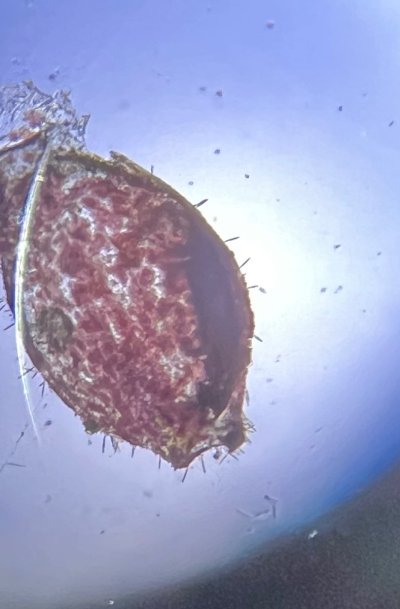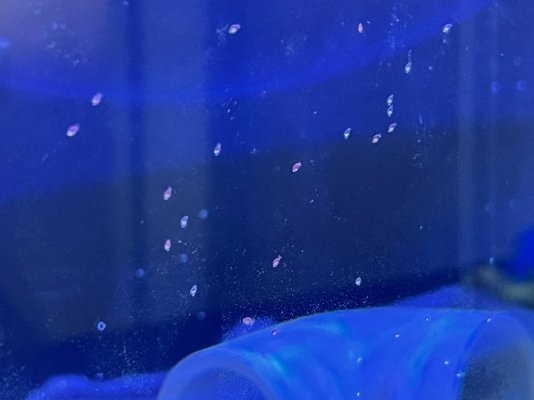Parasitic Crustaceans (Copepods, Isopods, and Sea Lice)
Jay Hemdal c.2020
This is an excerpt from my upcoming fish disease book - a section on arthropod parasites of fish; isopods and copepods.
------------------
Cause
This disease problem is caused by a variety of very small crustaceans that can parasitize fish. Some are obligate parasites with specific host species, while others are generalists and can live separate from a fish and only return periodically in order to feed on the fish’s skin. The different species have a wide variety of body shapes, but because they are all arthropods, they always have jointed legs and segmented body parts.Non-parasitic amphipods, copepods, and isopods are also common cryptic inhabitants of aquariums. Seen as little white specks moving about the aquarium glass, these creatures (often called “pods” by aquarists) are harmless but sometimes indicate that the primary inhabitants (the fish) are being overfed.
“Pod” characteristics
Amphipods tend to be flattened side to side and have two different types of legs. None of these are parasitic.
Copepods are flattened top to bottom, and non-parasitic ones often have large antennae. In parasitic species, the antennae are replaced with grasping hooks. So, if you see a large number of copepods, all with large antennae and not attached to a fish, they aren’t parasitic (though the parasitic species are free- swimming during the copepodite stage).
Female copepod with twin egg cases attached to the dorsal fin of a porcupine pufferfish. Photograph by Robert Fenner.
Isopods tend to have legs that are all the same (“iso” means “same,” and “pod” means “foot”). They are also either cylindrical or flattened top to bottom. The cirolanid isopods look a bit like pill bugs that you can find in your garden, but they are known parasites of fish.
Symptoms
Symptoms of copepod infestation can be a bit too general and vague for most aquarists to discern visually. The fish may flash (scratch), act nervous, or breathe heavily. In severe infestations, the fish’s skin will develop blood spots and the fins may become tattered.In older aquariums that have a high bio-load (large number of fish), an aggressive type of copepod may take up residence. These creatures hide in the gravel and under rocks during the day and swim up into the water column at night to feed on the fish’s skin. Fish in aquariums with an infestation of this type of copepod will be seen hovering near the surface, as far away from the substrate as possible. They may also show other signs of stress, such as pale coloration, jerking movements, and rapid breathing.
The purple firefish, Nemateleotris magnifica has a copepod parasite specific to that species – Serpentisaccus magnificae. Described by George Blasiola in 1979, this parasite is seen on newly imported firefish. The body of the parasite is buried in the flank of the fish, behind the gills, either on one or both sides. When the female copepod develops its egg sacs, these emerge from the fish’s skin as tiny coiled strands. Treatment should not be attempted for this parasite, as the adults are buried too deeply into the body of the fish for physical removal to be done safely, and no known chemotherapeutic will eliminate internal crustacean parasites without also harming the host fish. This copepod is thought to have indirect development with a series of planktonic larval stages, so there is no real concern of the eggs hatching and then fully developing and causing reinfection of the host.
| Over forty years ago, I saw a group of firefish at a wholesaler. One of the fish had a yellowish tangle of “tubes” protruding from its abdomen. At the time, I had learned that some collectors in the Indo- Pacific were utilizing tiny harpoons to capture gobies for the aquarium trade. The idea was, rather than using cyanide, the collector would spear the fish in a fin or other non-critical location in order to capture it. Indeed, Mandarin dragonets would show up at wholesalers with tiny holes in their fins from being captured in this manner. Going back to the firefish – my presumption then was that this particular fish had been speared in the gut, and these were its intestines protruding out. Visually, that all made sense, but the reality was, as I later learned, that the “intestines” were just the egg case of the copepod parasite. Things are not always what they seem to be! |
Diagnosis
Some crustacean parasites, including many of the isopods, are easily seen with the naked eye. In other instances, the female’s twin egg sacs can be seen emerging from under the fish’s skin. Branchiurans (Argulus) can sometimes be seen by observant aquarists, but as they are clear, their 10 mm bodies don’t stand out very well. Freshwater aquarists may find these on wild-caught freshwater stingrays.In other cases, such as with Ergasilus, the parasites are too small to be seen directly, so you need to look for secondary symptoms as mentioned above. A diagnostic dip will aid in the identification of these pests. The dip also serves as a temporary treatment, as it rids the fish of most of the parasites attached to it at that moment.
Treatment
The most frequently suggested treatment for crustacean parasites is the application of an organophosphate pesticide, such as Trichlorfon (Dylox or Metrifonate). These products are dangerous for aquarium use; toxic to the aquarist, and causing sensitivity reactions in many species of fish. Other treatments need to be considered first.One way to deal with these parasites in the aquarium is through a series of dips—formalin at 166 ppm for 45 minutes or fresh water for 5 to 7 minutes. Two difficulties are seen with this method, however. First, returning the fish directly to the infected tank allows for rapid reinfection. Second, these parasites have pinching mouthparts that make them difficult to dislodge during a dip treatment.
One method used by public aquariums is to give the entire aquarium a high-dose (166 ppm) bath with formalin. After about 30 minutes, the tank is very quickly drained to 20% full. Previously mixed seawater is then added to the tank to refill it. This process exposes the fish to about 45 minutes of formalin above 150 ppm and then leaves a residual formalin dose in the tank of 33 ppm, which is generally tolerated as a constant bath by most fish.
Obviously, this cannot be done in aquariums where invertebrates are present, and it does require a substantial amount of salt water. Furthermore, a second treatment is often required. For reef aquariums, removing the fish to a treatment tank and allowing the main aquarium to lie fallow for six weeks is the best treatment.
A copepod removed from a marine fish by a formalin dip.
Top view of a small isopod found infecting a marine aquarium fish.
A scad with a huge isopod removed from its gill chamber. The isopod made room for itself as it grew by eating away portions of the fish’s gill chamber. This single parasite proved fatal to the fish.
Insect Growth Regulators; Cyromazine and Diflubenzuron (Dimilin) are sometimes
used for the control of crustacean parasites in fish. Never apply these compounds in aquariums that house arthropod invertebrates. They only affect these parasites when they molt, so terminal molt adults are not harmed. This means that you must remove the adults through a dip process, while at the same time, dosing the exhibit to kill off all larval and sub-adult stages.
A spotfin butterfly fish (Chaetodon ocellatus) in the Bahamas with two Cymothoid isopods attached to its face. There was one isopod on the other side. The best treatment for these large parasites is careful physical removal (after sedating the fish). This fish was found in a disturbed habitat (a snorkeling area for a cruise line). Many fish in the area had damage, or were in poor condition, presumably as a result of all the people swimming in this marginal habitat.
###
Last edited by a moderator:














